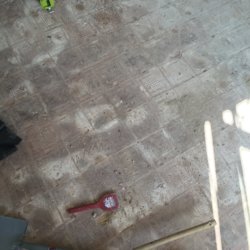S
Sam2494
Hi, We've just finished pulling up old quarry tiles ready to fit new Porcelain tiles throughout! Had to remove quarry's due to levels of external doors, were unsure what the subfloor is beneath the quarry's, I believe the property is prone to rising damp seeping through subfloor as no DPM.
I'm hesitant to lay self levelling onto subfloor incase moisture seeps through and blows it to bits and then everything will need to be ripped up!
I know you can get liquid DPM but would we get away with just tiling straight to sub base with Mapei Flexible adhesive? It's both flexible and completely waterproof so the damp shouldn't effect it at all? Or disrupt the new tiles? (Water may sit underneath I know as porcelain isn't a breathable covering like quarry tiles)
Has anyone got any advise or any pointers please?
Thanks
Attached is a picture of the subfloor now the quarry's have been taken up.

I'm hesitant to lay self levelling onto subfloor incase moisture seeps through and blows it to bits and then everything will need to be ripped up!
I know you can get liquid DPM but would we get away with just tiling straight to sub base with Mapei Flexible adhesive? It's both flexible and completely waterproof so the damp shouldn't effect it at all? Or disrupt the new tiles? (Water may sit underneath I know as porcelain isn't a breathable covering like quarry tiles)
Has anyone got any advise or any pointers please?
Thanks
Attached is a picture of the subfloor now the quarry's have been taken up.

